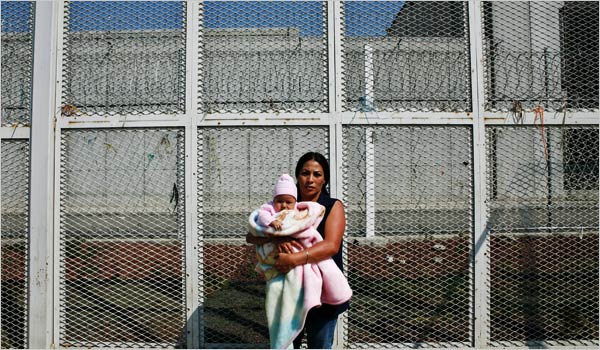| Want to send this page or a link to a friend? Click on mail at the top of this window. |
More Special Reports |
| Posted January 1, 2008 |
| MEXICO JOURNAL | |||
|
|||
 |
|||
ADRIANA ZEHBRAUSKAS FOR THE NEW YORK TIMES |
|||
| Victoria Jaramillo, 40, holding her 3-month-old daughter, Frida, at Santa Martha Acatitla, a women's prison in Mexico City. |
By JAMES C. McKINLEY Jr. |
MEXICO - Beyond the high concrete walls and menacing guard towers of the Santa Martha Acatitla prison, past the barbed wire, past the iron gates, past the armed guards in black commando garb, sits a nursery school with brightly painted walls, piles of toys and a jungle gym.
Fifty-three children under the age of 6 live inside the prison with their mothers, who are serving sentences for crimes from drug dealing to kidnapping to homicide. Mothers dressed in prison blue, many with tattoos, carry babies on their hips around the exercise yard. Others lead toddlers and kindergartners by the hand, play with them in the dust or bounce them on their knees on prison benches.
Karina Rendón, a 23-year-old serving time for drug dealing, said her 2-year-old daughter thought of the 144-square-foot cell she shared with two other mothers and their children as home. “She doesn’t know it is a prison,” she said, smiling sadly. “She thinks it’s her house.”
 |
ADRIANA ZEHBRAUSKAS FOR THE NEW YORK TIMES |
| Jacqueline Merlos Espericueta, 2, playing during a Christmas party at the prison, where her mother, Diana, is awaiting trial. |
While a prison may seem an unhealthy place for a child, in the early 1990s the Mexico City government decided it was better for children born in prison to stay with their mothers until they were 6 rather than to be turned over to relatives or foster parents. The children are allowed to leave on weekends and holidays to visit relatives.
A debate continues among Mexican academics over whether spending one’s early years in a jail causes mental problems later in life, but for the moment the law says babies must stay with their mothers. So the prison has a school with three teachers.
The warden, Margarita Malo, said the children had a calming effect on the rest of the inmates. The presence of children also inspires the mothers to learn skills or, in many cases, to kick drug habits that landed them in trouble in the first place.
And even though the prison is full of women capable of violence, the children usually walk safely among them, as if protected by an invisible shield. It is as though they tap the collective maternal instinct of the 1,680 women locked up here.
“The minors are highly respected by the population,” Ms. Malo said. “The fact we have children here creates a mind-set of solidarity. I have never seen aggression on the part of the inmates toward the children. Everyone acts as if they could be their children, and they don’t want anything to happen to them.”
Still, raising a child in prison presents a tough set of problems, mothers said in recent interviews. Those serving long sentences dread the day when they must be separated from their child because he or she has turned 6.
Others who lack financial help from relatives struggle to earn enough money in prison to care for a child. Several said they waged a constant struggle to keep their children from getting sick in the damp, drafty cells. They often have no money for the prescriptions the prison doctor gives them.
Yet, few want to give up their bright-eyed offspring to relatives on the outside. They say the children are like a breath of normal life inside the stuffy, deadening confines of the prison. “It’s beautiful,” said Victoria Jaramillo, as she held her 3-month-old daughter on her lap. “It keeps one busy.”
Ms. Jaramillo, who is 40, is serving a 20-year sentence on a drug-dealing conviction. She maintains that she was only ironing clothes in a house when the police burst in and discovered a cache of drugs. Whatever the truth, she faces the certainty that she will have to give up her daughter, Frida, in six years.
“The only thing that bothers me is I will have to lose her,” she said. Dressed in a pink fleece jumpsuit, the baby looked up at her mother with dark, innocent eyes.
A mother’s crime plays no role in the decision to let her keep a baby born in jail, the warden said. Cecilia Nava López, 25, has served two years of a 27 ½-year sentence after being convicted of causing her stepchild’s death, a charge she denies. She was pregnant with her fourth child when the death occurred, and she was incarcerated based on the testimony of the father of her children.
Ms. Nava López said it was hard to keep her spirits up, facing such a long sentence for a death she said was not her fault. But taking care of her son, Emmanuel, who is 20 months old, gives her life some meaning. “He motivates me to keep trying to improve myself,” she said.
Ms. Rendón, however, said she sometimes wished she could give her daughter to relatives to raise. No one gives her money, so she makes a living selling snacks to visitors. Her child is delicate and gets sick frequently with chest colds, she said. She said she considered the prison food unhealthy, so she buys food for the girl from a grocery store the prison allows to operate inside its walls.
“I think the best thing for my daughter would be for her to be outside with her grandmother,” Ms. Rendón said. “I have to take her to work with me.” She pauses. “But the truth is I need her. She is something very special.”
Cell doors clang open at 7 a.m. and the guards call the roll at 8 a.m. Most of the mothers live together on the bottom floor of Cellblock H. They take their children to the school at 8:30 a.m. and pick them up at 2:30 p.m. The children spend the rest of the day in their mothers’ cells or with their mothers in the exercise yards.
The school has barbed wire above a yellow sign reading Cendi, short for Centro de Desarrollo Infantil, the Center for Child Development. On a recent afternoon, the children and their mothers gathered for La Posada, a traditional Mexican Christmas celebration. They sang songs about Joseph and Mary’s search for a place to stay in Bethlehem and the birth of Jesus in a manger. Then the children broke a star-shaped piñata and scrambled after the candy. It was hard to believe that they were surrounded by prison walls.
Elsa Romero Martínez, a psychologist who runs the school, said the children showed no signs of overly aggressive behavior. There have been few reports of abuse, though one child, suffering bruises, was taken away from a cocaine-addicted mother two years ago.
The thorniest problem she and the teachers face is preparing the children and mothers for separations once the children reach 6. “We have to teach them to say goodbye to the mothers,” she said.
To show them that a wider world exists, the teachers try to take the children on field trips as often as possible. Their budget is limited and they rely on charity for the outings. They have managed only three this year — to a museum, an amusement park and a children’s theater. Some of the mothers live in a state of limbo, because a third of the prisoners have yet to be convicted of a crime. Diana Merlos Espericueta, 24, was arrested in December 2004 on charges of being a member of a kidnapping ring. She maintains that she dated the gang leader, the father of her child, but knew nothing of his business dealings.
For three years, she has waited for a judge to decide her case. She gave birth to her daughter, Jaqueline, soon after being incarcerated and has watched her grow to become a sprightly toddler, not knowing what the future holds for them. She faces a long sentence, possibly 70 years, if convicted.
Watching her child play amid plastic balls at the prison’s school, she said she lived in a state of impotent fear. Sometimes, she said, she contemplates committing suicide if she is forced to spend the rest of her life in jail and to give up her child. “The confinement is very hard,” she said.
Copyright 2007 The New York Times Company. Reprinted from The New York Times, International, of Monday, December 31, 2007.
| Wehaitians.com, the scholarly journal of democracy and human rights |
| More from wehaitians.com |